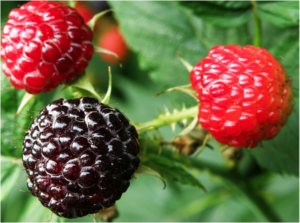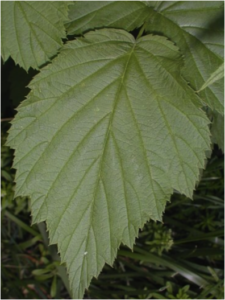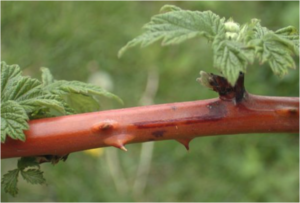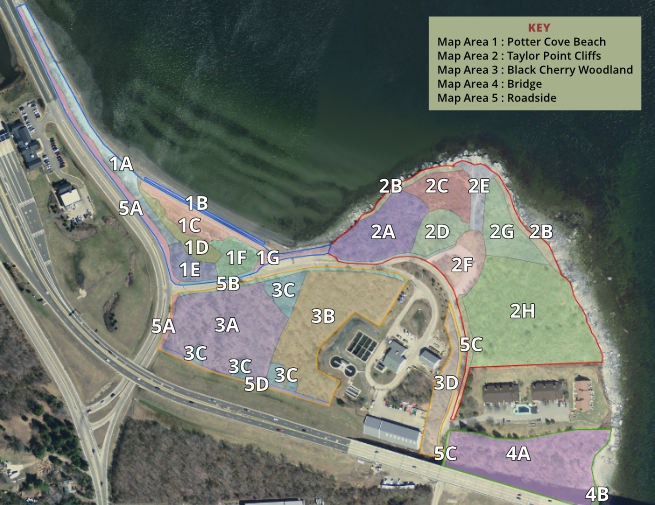Common Name: Black Raspberry
Specific Name: Rubus occidentalis
Known Occurrence at Taylor Point:
Map areas: Beach 1A, Cliffs 2B, 3? 4?
Category: Native, Shrub

Ecological Considerations:
Rubus occidentalis, commonly called Black Raspberry, is a perennial shrub that produces little-branched canes up to 6′ long during the first year. These canes are initially erect, but they eventually arch sideways and downward. First-year canes are vegetative and do not produce flowers and fruit. They are initially green, hairless, and glaucous, but later turn brown and woody during the winter. Scattered along the length of each cane are prickles that are short and curved.
Second year canes develop short branches that terminate in flowers. Along the length of these canes, there are alternate compound leaves. These compound leaves are usually trifoliate; rarely are they palmate with 5 leaflets. The leaflets are up to 3″ long and 2″ across. The flowers are bunched tightly together and each is about ½” across, consisting of 5 white petals, 5 green sepals, and numerous stamens. The blooming period occurs during the late spring or very early summer and lasts about 2-3 weeks.
Fertile female flowers produce an edible juicy berry composed of multiple drupelets, each drupelet containing a single seed. The berry is about 1/3 to 1/2 inches across with a hollow (depressed) base when separated from the stem. The fruit turns purple-black when mature
The root system consists of a woody branching taproot. Vegetative offsets are often produced by the canes rooting at their tips.
Map areas where this plant can be used for revegetation:
Propagation Mechanisms/Strategies for Encouraging its Establishment:
Best Planting Practices/Options and Pros and Cons of Options:
Black Raspberry’s preference is partial sun, moist to slightly moist conditions, and rich loamy soil. In areas that are too sunny and dry, the fruit may not develop properly without adequate rain. The canes also fail to set fruit if there is too much shade.
Key Issues Regarding its Ecology ( e.g. Which Invasives Threaten it, What Conditions Favor it):
Associated Ecological Benefits:
The nectar of the flowers attracts bees primarily. Less often, small butterflies may visit the flowers for nectar. Insects that chew on the foliage or suck sap include caterpillars of various moths, spider mites and flea beetles, and leafhoppers. The fruit is an important source of food for many birds. Raccoons, squirrels, and chipmunks occasionally eat the fruit, while rabbits and deer browse on the foliage and stems.
Availability of Locally Sourced Seeds and Plants:
Case Studies of Native Plant Establishment Efforts/Lessons Learned:
Additional photos:



Sources cited:
Search at Rhode Island Native Plant Guide
Illinois Wildflowers
Friends of the Wildflower Garden
Key Words:
Native
Shrub
Black Raspberry
Rubus occidentalis
